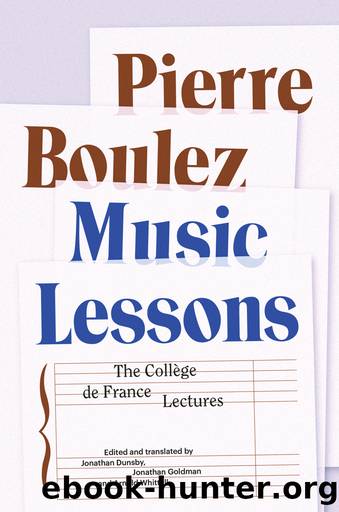Music Lessons by Pierre Boulez

Author:Pierre Boulez
Language: eng
Format: epub
Publisher: The University of Chicago Press
Published: 2005-06-15T00:00:00+00:00
11
Between Order and Chaos1 (1987â88)
Of professional musiciansâ abilities about which the amateur may ask, one immediately thinks of their being able to imagine, purely from reading a score, the sound of the result. How do they mentally transcribe the written code and fully understand not only what it means, but also what it represents? Are they so secure in this mental representation as to be able to access it without any possible mistake, without reality intruding to spoil some detail or even confound everything? When beginning to study solfège, one learns to listen analytically in order to be able to transcribe the musical object brought to our attention. What we have is a copy of the real thing, rather like in a basic drawing lesson: melodic intervals or chords are reproduced in the same way that one reproduces a cup or a spoon; the code for transcribing will work differently, but this is the same kind of operation. Later, when one studies composition â harmony, counterpoint, fugue â the first recommendation, if not requirement, is to avoid relying on the sounding object itself: as they say, âDo not use the help of the piano or you will never learn to hearâ; in other words, you have to suppress any direct form of reference. Hearing, however, is not captured just by that negative command. It implies much more than imagining the target musical object: it implies conceiving the precise network of satisfying relationships between any given data and their implications, which have to be identified and absorbed correctly. If you are offered a melodic line, you have to find a harmonic accompaniment to realise the functions implied by this melodic line. When these functions are simple, it is relatively easy to crack the code they are following, and of which they are the outcome; when they are more ambiguous and complex, there may be various solutions which have to be created and which must be clearly hearable. The writing being taught may be vocal, but in fact these exercises take place in a kind of sonic vacuum, and they are checked cursorily by the teacher at the piano, who will reward you with a ânot heardâ, an ignominious scribble to make you aware of how little your internal hearing has to do with reality. You have heard neither the object nor the relationship between objects; your only way to check it is through sonic realisation. After study of that kind, rigorous about the virtual representation of an object, you will certainly be inclined to believe Mallarméâs idea of the âideal flower absent from all bouquetsâ, which for the musician can mean the note absent from all objects.
Such teaching can seem absurd in denying something that is more essential among the musicianâs gifts: knowing how to deal with material in sound, the required, abstract task seeming not to lead as directly as possible to this inevitable encounter. And yet behind this teaching there lies the ambivalence that will be the composerâs lot
Download
This site does not store any files on its server. We only index and link to content provided by other sites. Please contact the content providers to delete copyright contents if any and email us, we'll remove relevant links or contents immediately.
| Appreciation | Blank Sheet Music |
| Composition | Conducting |
| Exercises | Instruction & Study |
| Lyrics | MIDI, Mixers, etc |
| Philosophy & Social Aspects | Songwriting |
| Techniques | Theory |
| Vocal |
The Goal (Off-Campus #4) by Elle Kennedy(13460)
Kathy Andrews Collection by Kathy Andrews(11706)
Diary of a Player by Brad Paisley(7458)
What Does This Button Do? by Bruce Dickinson(6121)
Assassin’s Fate by Robin Hobb(6101)
Big Little Lies by Liane Moriarty(5677)
Altered Sensations by David Pantalony(5027)
Pale Blue Dot by Carl Sagan(4883)
Sticky Fingers by Joe Hagan(4083)
The Death of the Heart by Elizabeth Bowen(3530)
The Heroin Diaries by Nikki Sixx(3478)
Beneath These Shadows by Meghan March(3248)
Confessions of a Video Vixen by Karrine Steffans(3229)
How Music Works by David Byrne(3156)
The Help by Kathryn Stockett(3066)
Jam by Jam (epub)(3003)
Harry Potter 4 - Harry Potter and The Goblet of Fire by J.K.Rowling(2971)
Strange Fascination: David Bowie: The Definitive Story by David Buckley(2780)
Petty: The Biography by Warren Zanes(2681)
